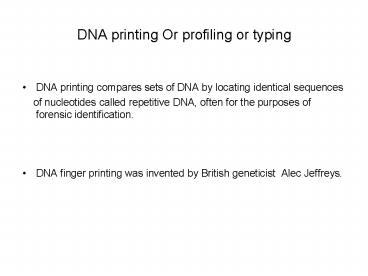DNA printing Or profiling or typing - PowerPoint PPT Presentation
1 / 15
Title:
DNA printing Or profiling or typing
Description:
DNA printing Or profiling or typing DNA printing compares sets of DNA by locating identical sequences of nucleotides called repetitive DNA, often for the purposes of ... – PowerPoint PPT presentation
Number of Views:60
Avg rating:3.0/5.0
Title: DNA printing Or profiling or typing
1
DNA printing Or profiling or typing
- DNA printing compares sets of DNA by locating
identical sequences - of nucleotides called repetitive DNA, often
for the purposes of forensic identification. - DNA finger printing was invented by British
geneticist Alec Jeffreys.
2
Principle of DNA finger printing
- DNA finger printing is based on the fact that DNA
of one individual is about 90 identical to the
DNA of another individual, but there is 10 of
DNA that is different from others. - This 10 of the total DNA is important, it does
not code for any protein or RNA. - It carries some specific short sequences.
- The specific sequences are tandem repeated many
times and are present throughout the length of
DNA. - These repetitive DNA s are more in satellite part
of a chromosome, or in Kinetochore, or in nuclear
organizing regions. - The number of repeats is very specific in each
individual, and it is inherited.
3
POLYMORPHISM IN DNA.
- The number of repetitive sequences present at one
locus of an individual differ from the number of
repetitive sequences present in the other locus
of the same individual, and the repetitive
sequences are with different number of nucleotide
base pairs. This phenomenon is called
polymorphism. - Where as the other individual is likely to have
different numbers of repeats at these loci. - Polymorphic genetic loci are called simple
tandem repeats. - Tandem repeats of short sequences are called
Variable number tandem repeats.
4
Sources of DNA for finger printing.
- From blood, semen stains, saliva residues, tissue
bits, or even hair follicle.
5
Steps involved in DNA finger printing technique.
- 1.Isolation of DNA
- 2. Digestion of DNA by Restriction Endonucleases.
- Separation of DNA by electrophoresis.
- Transferring of DNA separated fragments to
synthetic membranes such as nitrocellulose or
nylon. - Hybridization using labeled VNTR probe.
- Detection of hybridized DNA fragments by
autoradiography.
6
Isolation of DNA
- DNA molecule is isolated from the source by high
speed refrigerated centrifuge. - Bulk DNA forms a major peak, small peaks are
formed by satellite DNA. - Alec Jeffreys used satellite DNA as a probe.
- Satellite DNA are of two types. One is mini
satellites, and micro satellites. Based on number
of base composition, length of segments and
number of repetitive units.
7
Amplification of DNA
- If the amount of DNA available is less, the
available DNA is amplified to increase the amount
of DNA by polymerase chain reaction (PCR).
8
Digestion of DNA with restriction endonucleases
- Endonucleases are called molecular scissors.
- They splice the DNA at a specific site.
- They cut the DNA at specific sites.
9
(No Transcript)
10
Separation of DNA by Gel electrophoresis.
- It is the method used to separate the DNA
fragments based on their charge to mass ratio. - It requires a glass vesssel called well. The
contains polyacrylamide solution. - The DNA fragments move towards anodes based on
their charge to mass ratio. - Fragments with low charge to mass ratio move
downwards towards anode. - The various fragments form bands.
11
Transferring of separated DNA strands on to
synthetic membranes.
- After separating DNA fragments by
electrophoresis, the fragments are transferred on
to synthetic membranes like Nitrocellulose or
Nylon by a technique called Southern blotting
technique.
12
DNA probe.
- DNA probes are repeated sequences of DNA
complementary to those present in VNTRS. - These probes are made radioactive.
- The radioactive DNA probes bind with the
repetitive sequences on the nylon sheet. This is
called hybridization.
13
Autoradiography.
- An X ray film exposed to the nylon sheet to mark
the places where the radioactive DNA probes have
come to bound to the DNA fragment. These places
are marked as dark bands when X-ray film is
developed. This process is called
autoradiography. - The dark bands represent the DNA finger prints or
the DNA profiles.
14
Applications of DNA technology.
- In settling the paternity disputes, that is in
determining of biological father of child. - In detecting criminals.
- In ascertaining of an immigrant under scrutiny c
15
(No Transcript)































